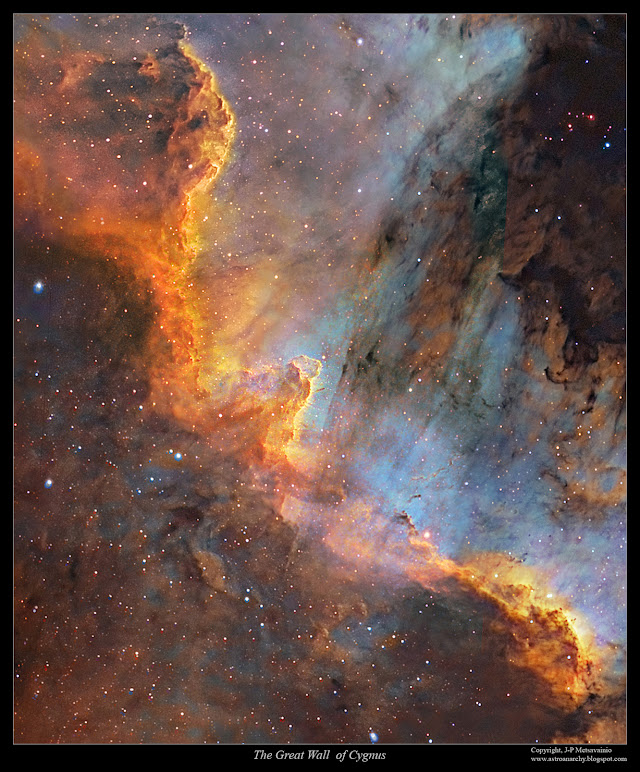COPYRIGHT, PLEASE NOTE
Monday, December 20, 2021
Cygnus mosaic gets large
The Deepest and Most Detailed Image of the Entire Cygnus Constellation Ever Captured
This new composition is designed to frame the Veil Nebula supernova remnant within the field of view.
In this image, three large supernova remnants are visible. The Veil Nebula is the brightest among them, while the other two are extremely faint and diffuse. To make these two remnants more visible, I dedicated approximately 200 hours of exposure time to capturing them alone. I like to call this trio The Three Musketeers.
I’m particularly pleased with this new composition—it’s dynamic and, for the first time, showcases the entire Cygnus constellation at this level of detail and depth. At least, I haven’t seen anything quite like it before. The image spans 31 × 23 degrees of the sky and is composed of 118 individual frames. The total exposure time is around 700 hours, and the final resolution is an impressive 20,000 × 25,500 pixels. This photograph was over a decade in the making, from 2010 to 2021.
The previous version of this mosaic can be seen here: Great Mosaic of Cygnus.
Three large supernova remnants in the same field of view
Click for a large image
ZOOMABLE VERSION
Click for a large image

Three large supernova remnants in constellation Cygnus, the Swan, are in image as colored circles
NOTE, there is an apparent size of the Moon as a scale at lower right corner in a grayscale image.
INFO
Three Supernova Remnants, Two Wolf-Rayet Stars, and a Black Hole
In the orientation image above, three large supernova remnants are visible. The first is the Cygnus Shell (W63), a bluish ring located toward the middle left. The second is the large supernova remnant (SNR) G65.3+5.7, positioned in the upper right. The third is the brightest of the three, the Veil Nebula, found along the right edge of the image.
Beyond these supernova remnants, two Wolf-Rayet stars with outer shell formations can be seen. The first is NGC 6888, the Crescent Nebula, located at the center of the image. The second is WR 134, appearing as a blue arc just to the right of the Crescent Nebula, near the Tulip Nebula.
Next to the Tulip Nebula lies the black hole Cygnus X-1. It is marked in a small close-up of the Tulip Nebula, positioned in the center-right section of the orientation image above.
The Cygnus constellation is an endless source of celestial wonders, both scientifically and artistically. As a visual artist, I find this region of the night sky incredibly inspiring. Its intricate structures and mesmerizing shapes captivate me—I could easily spend a lifetime capturing images of this cosmic treasury.
Equipment Used
Over the years, I have employed multiple optical configurations to assemble this mosaic image. Until 2014, I worked with an old Meade LX200 GPS 12" telescope, a QHY9 astro camera, Canon EF 200mm f/1.8 camera optics, and a Baader narrowband filter set.
Since 2014, I have been using a 10Micron 1000 equatorial mount, an Apogee Alta U16 astro camera, a Tokina AT-X 200mm f/2.8 camera lens, and an Astrodon 50mm square narrowband filter set.
Additionally, I have captured many detailed images using longer focal lengths. Before 2014, I used the Meade 12" scope with a reducer, and after 2014, I switched to a Celestron EDGE 11" with a reducer. My guiding cameras have included the Lodestar and, later, the Lodestar II
Monday, December 13, 2021
The Pelican Nebula with new data
I originally publish this nebula image at December 2016. After that, I have shot some very high resolution material from the same area of sky and I decided to upgrade my old image with better data. I'm kind of happy with the result, especially the details in dark nebulae are much sharper now and shows the complex structures of unionized gas and dust. Main reason is the long exposure time used, for H-alpha alone, there are 30 hours of exposures. Total exposure time is around 60 hours.
The dark nebula in the upper part of the photo is the gas bridge splitting visually the Pelican Nebula and the North America nebula so that the they look like two separate nebula. In reality they are actually a one large emission area.
Zoomable Image
Wednesday, November 24, 2021
The Great Wall of Cygnus
Due to very cloudy weather I have remade some of my older photos, this time the Cygnus Wall has been remade. This is a combination of several older images from 2008, 2010 and 2014. Two different longer focal length telescope was used, The Meade LX200 GPS 12" and Celestron Edge 11". Beside long focal length images material from shorter focal length optics was used from the Canon EF 200mm f1,8 and Tokina AT-x 300mm f2.8 camera optics. Older material was taken with the QHY9 astro camera and after 2014 Apogee Alta U16 camera was used. Total exposure time is around 30 hours.
Click for a large image

Mapped colors from an emission of the ionized elements, Red=Sulfur, Green=Hydrogen and the Blue =Oxygen.
Wider field
Click for a large image
Wednesday, November 10, 2021
NIGHT FEVER, exhibition in Helsinki 14.10 - 04-12. 2021
NIGHT FEVER
THE PLATFORM GALLERY
Lapinlahdenkatu 16 C, 00180 Helsinki
The exhibition will be open in the the evenings to highlight the
beauty and mystique of the cosmos.
Opening hours
Wed - Fri: 5pm to 9pm
Sat: 2pm to 8pm
We are also open on select Sundays and Holidays and
outside opening hours by appointment















